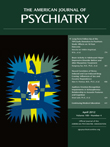In This Issue
Higher 10-Year Recovery Rate With Early Psychosis Detection

A program for early psychosis detection combined publicity and easy access to care (Hegelstad et al., p. 374)
Patients with psychotic disorders living in an area with a program for early detection of psychosis had a 31% recovery rate 10 years after their initial treatment, compared with 15% for those in an area without early detection. Hegelstad et al. (p. Original article: 374) report that patients in the early detection program were also more likely to have full-time work but were less likely to live independently (figure). The two groups had mostly similar symptom levels, but as noted in the editorial by Cannon (p. Original article: 345), severely impaired patients were overrepresented in the dropouts from the group without early detection.
Activity in brain regions linked to substance abuse was greater in cocaine-dependent women than in non-substance-abusing women after stress but not after exposure to drug-related cues. For men with cocaine dependence, the pattern was reversed: more widespread hyperactivation after drug-related cues than after stress. Clinical possibilities raised by Potenza et al. (CME, p. Original article: 406) include targeted treatment for cocaine dependence: stress reduction for women and 12-step or cognitive-behavioral approaches for men. The editorial by Moeller (p. Original article: 351) relates the findings to the three stages of the addiction cycle: binge/intoxication, withdrawal/negative affect, and preoccupation/anticipation.
The “Emotion Paradox” in Schizophrenia
The finding that patients with schizophrenia report levels of current pleasure comparable to those of healthy subjects but report less pleasure in past or hypothetical situations—the “emotion paradox”—could be due to cognitive impairments, suggest Strauss and Gold (p. Original article: 364). Problems in the encoding or retrieval of memories of pleasurable experiences may lead to distorted beliefs about the possibility of pleasure. This conceptualization suggests a role for cognitive-behavioral therapy in treating anhedonia in schizophrenia patients.
Hudak and Wisner (CME, p. Original article: 360) describe women with intrusive thoughts of harming their infants and rituals that result in avoidance of their babies. Differential diagnosis of women who develop these symptoms includes postpartum major mood disorders, obsessive-compulsive disorder, and psychosis with infanticidal thoughts. Rapid onset in the postpartum period of anxiety and obsession is common. Insight into the obsessive unreality of rituals to avoid harm is a key diagnostic feature. Treatment includes serotonergic drugs, psychoeducation to help the woman understand that she is unlikely to harm her infant, and exposure with response prevention therapy.
Schizophrenia Patients Miss Voice Cues
Individuals with schizophrenia have an impaired ability to recognize emotions in other people's voices, and this impairment is related to the perception of pitch, but not loudness. This difficulty was also correlated with lower scores for problem solving in the study by Gold et al. (p. Original article: 424). Distorted perception of others' emotions can contribute to poor psychosocial functioning in schizophrenia, and editorialists Keefe and Kraus (p. Original article: 354) describe the connection between in-the-moment experience and a person's relationships to others.
Antidepressant Normalizes Brain Activity in Depressed Adolescents
Limbic and cortical brain responses to images of fearful faces were greater in adolescents with major depression before treatment than in healthy adolescents, but the differences faded after 8 weeks of fluoxetine treatment. The imaging study by Tao et al. (CME, p. Original article: 381) also showed that the brain regions affected in the depressed adolescents are mostly the same as those in depressed adults. Cullen states in an editorial (p. Original article: 348) that the normalization of brain activity gives clinicians a powerful message for patients and families about the value of antidepressant treatment.



